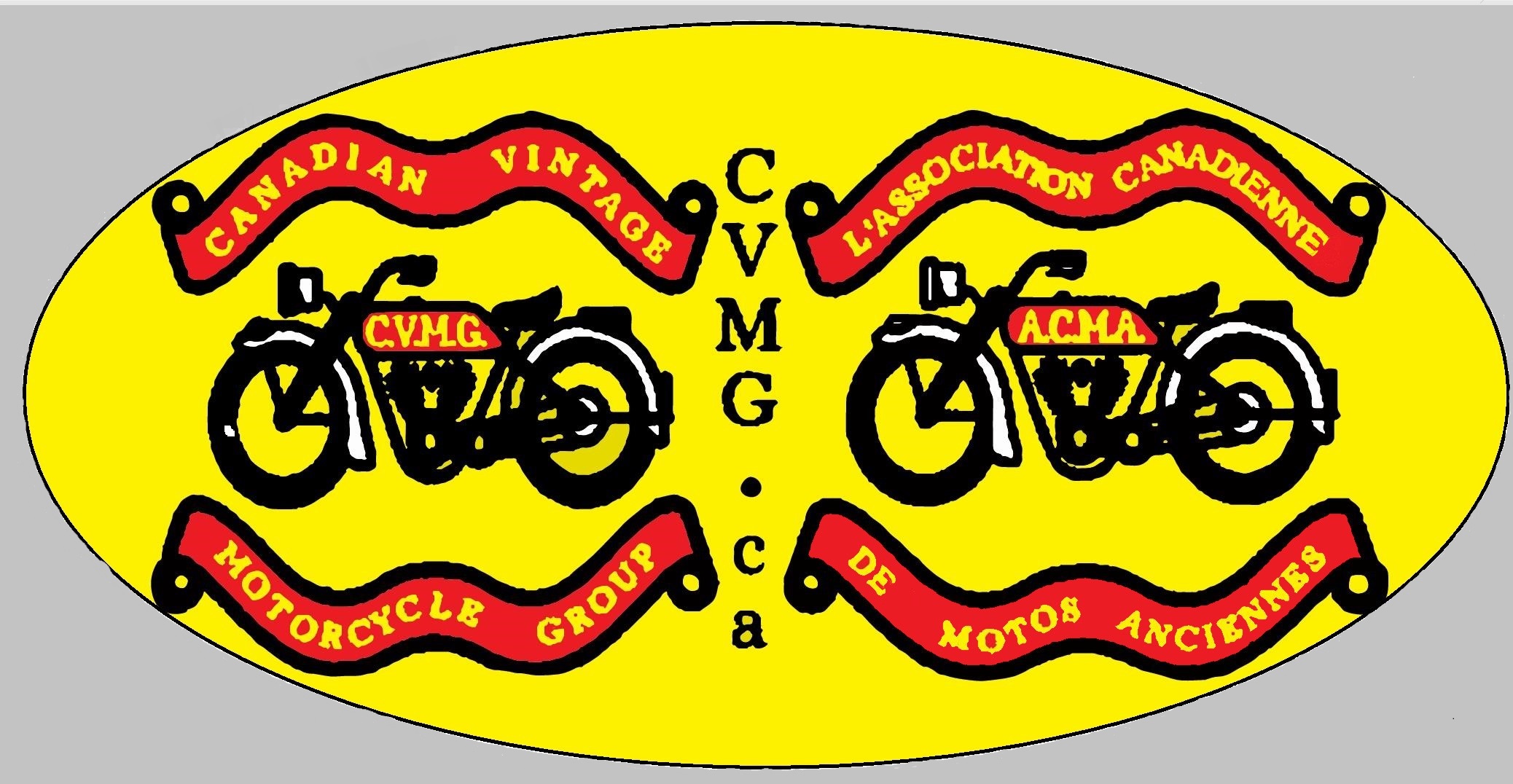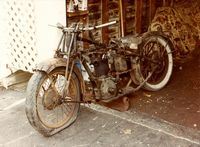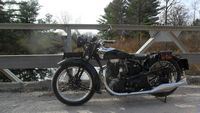Canadian Vintage Motorcycle Group L'Association Canadienne de Motos Anciennes |
| Pour traduire ce site Web dans une autre langue, cliquez sur « Select Language » au bas de la page. |
MEMBERS RESTORATIONS Members' recently acquired bikes: 1967 honda 175 1949 Norton ES2 1975 Yamaha RS100 My 1931 Ariel Restoration
In 1977, I was a long-haired 20-year- old who really couldn’t tell the difference between a Triumph and a Norton. That spring would change my life forever. My first vintage motorcycle had just been purchased and I had no idea what a 1953 Ariel VHA 500cc single was. The Ariel was located in Frankford, Ont. The seller’s brother rode the Ariel up 1961 just before he died; they pushed it into a barn where it sat until that day in 77. I now have the disease and my next Ariel came in 85 and that was a 1932 600cc OHC. During the summer of 1986, I received a call from Wes Fraser who informed me he had a lead on an Ariel in Napanee and thought I would be interested. I sure was! I made a phone call to my good friend Dave Lacombe and soon we were off in search of this rumoured Ariel. What I laid my eyes upon was a rusty wreck that looked like it had caught fire at some time in its life. I looked closer, the bars are original, the T bar for steering adjustment was there as the hand shift & linkage, saddle, oil tank but missing gas tank, gearbox, etc. Ok, this was a challenge indeed, I then asked how much? $250 he replied, deep breath, I then offered $150. Long pause..Ok. I’ll take it he replied. Once home the laughter began. Yes, laughter and I bet some of you have had the same reaction to your acquisitions at some point over the years. All I knew at this stage I bought an Ariel but what model & year? Pre-internet days meant writing letters to the Ariel club, what I had was a 1931 VF 500 single. The Ariel was slowly stripped down & parts inspected. The forks were straight, the rims & spokes were tossed to the garbage bin. Surprisingly the front & rear hubs were in good shape as were the wheel bearings. The engine cases were split, the big end bearing was worn out, no piston, the valves & guides were serviced but at some point, they would need to be replaced. The cases were cleaned using soap & hot water. A local bearing company supplied the bearings. They were inserted and the cases put away. The search for parts began; Bernie from Nicholson Bros supplied the Big end bearing. Mike Duncan (Mikes Motorbikes) assembled & trued the crank. Draganfly Motorcycles supplied the NOS +30 piston. I had lucked out as they told me this was their last NOS piston. Drags also supplied spokes and Italian rims which quickly rusted. Leitner & Bush made the new liner. Ken Rosevear supplied a 1928/29 Burman Q gearbox and I bet Ken wished he still had it. Vic Horley in Sweden supplied a dented but useable gas tank. Ron Brooks welded the missing front piece to the front fender, cut off by one of the previous owners. Footpegs came from the UK. A later magneto was bought at the Annual CVMG National Rally in Paris, the clutch is the taper type and I just happened to have one up in the rafters. What luck! Then around 1992, the bike sat as I was unable to continue due parts being unavailable. Fast forward to about 2008, the gas tank was sent to Draganfly for restoration. 5 years later Draganfly notifies me it’s finished. This was the motivation I needed to have another look at the Ariel. 2015: Gregg Kricorissian from Ottawa overhauled the Magneto & Generator. The DVR-2 electronic regulator came from the UK; it’s small and hides out of sight. Rick Wood machined the layshaft to accept the new speedo drive gear. In the fall I finally had the Ariel Insured & Licensed, the ol girl was ready for the road. Some teething issues were noted and with winter coming this would be a good time to sort them. 2016: During the winter I decided to have the valves & guides done. I contacted Peter Kemp of the Ariel single spares (Ariel Owners Club UK). Peter suggested I use the “G” Valves & Guides Ariel used on the sportier 1930 “G” Model as they were less prone to breaking. I took the cylinder head to TDC Engines in Kingston for them to work their magic, it was then we decided to install new valve seats as well. My next purchase was a Sportier cam (664 cam as used on the “G”) to give a little more performance over the original soft “F” Cam. On a Hot Wednesday evening, I rode the 31 over to the Madoc Cruise night and to meet fellow CVMG member Al Cooney at Hwy 62. Sandra followed me down Quin-Mo-Lac road in the truck. 3 miles on the clock the Ariel tightened up, pull in clutch, coast, let out clutch and boom she fires, this got me a fair distance until she refused to go no more. As Al waited, I let the 31 cool down for 10 minutes, try again and away we went to Madoc without another issue. Once home I pulled the top end off to inspect why it tightened up. It turns out my request for piston clearance of .005 was not used but .0035 instead. These old aluminium alloy pistons need a lot of clearance due to their expansion rate. Gary McCaw came to the rescue and cleaned up my cylinder along with the required .005 clearance. New rings from Cox & Turner in the UK were a perfect fit for this 2 compression ring piston. Ariel didn’t use an oil control ring until 49 when they switched to a larger capacity oil pump. Wet sumping was another issue I tried to solve. For no reason, it would just stop returning oil to the tank. A quick clean of the pump always solved the problem but why? I ordered new springs & balls from Draganfly thinking this would solve the issue. Even with new balls & springs, it would just stop returning oil anytime, anywhere. An Ariel Club member noted he had the same issue and he ended up replacing the pump, no more issues. A better pump has now been installed. I switched to LED bulbs on both of my Ariel’s, what a difference that made. I can now ride with the lights on with no charging issues. A fellow Ariel Club member pointed me to the Slovakia Ariel Klub for parts. They supplied the correct 30/31 “Q” gearbox and a new clutch sprocket. The Ariel UK club gearbox spares supplied new clutch cushion rubbers and rollers. The clutch basket had deep grooves where the clutch plate tangs rode in. I welded the grooves up and filed them all down to size. Clutch Plates for the early Burman clutch came from Darganfly. One problem “Q” boxes have is worn drive sprocket grooves on the final drive. There is no locking tab washer used as on later Burman boxes and this allows the nut to eventually become loose allowing the sprocket move. A gentleman in Australia machined a batch of final drive gears, sprockets, and nuts. To help keep the engine oil clean, I added a “Unique oil filter” The filter uses a Royal Enfield oil filter which is inexpensive and readily available. 2017: During the winter I ordered a new set of “British made” chrome rims & stainless spokes for both wheels. With the rear hub sitting on the bench a close inspection showed some of the teeth were breaking off. I ordered a later style rear sprocket from Draganfly. This isn’t a bolt fit on the 31 as the sprocket is cast into the rear hub. I drove to Stirling to see Kevin at Coulter Machine to see what he thought. Easy he said, a week later it was finished. This year as a challenge, I decided I would enter the Ganaraska 250; a Motogiro event on the 31. I teamed up with Ian Cooper aboard his 29 Panther and I proudly say both bikes completed the event with no issues although the Ariel had higher than normal oil consumption. It was then I decided to modify the piston to accept an oil control ring. This had to be one of the best modifications I’ve done to the bike. 2019: Jumping forward to 2019, I now have close to 1000 trouble-free miles on the 31. Two questions I get asked are:,How hard is the 500 to start and how does it ride. The starting procedure is typical British Single. Turn fuel on, depress float tickler until fuel squirts out or in my case I count to 4, kick over until compression is felt, pull in the exhaust lifter, ease past TDC. I then set the advance/retard lever to half, open throttle and a good healthy kick usually brings it to life. After a brief warm-up, the advance lever is set to full advance, pull in the clutch and push the gear change lever downwards to first. First and second gear are about right but the jump to 3rd is big. You must wind it out in 2nd to about 35mph then shift, the revs drop to a Thump…Thump, and engine speed slowly builds. Once it reaches 40 mph it starts to come into its own as they say. 45-47 mph is where it likes to be but will cruises at 50 mph no problem. Despite what many think a vintage machine is like, the Ariel is surprisingly very smooth. It handles potholes reasonably well, better than one would think. Brakes are 1930’s so one must be prepared for the unexpected and to keep one’s distance behind cars. The engine braking does most of the slowing down when approaching stop signs. You must remember when these bikes were made, roads in Ontario were dirt roads and to clip along at 40 mph was a good speed, to hit 50 mph was WOW! I’m blessed with some great back roads here, both hard packed and paved. I can ride the Ariel to Belleville all on back roads and then take a different route home. I obtained a dating certificate from the Ariel Owners Club; it appears only 12 of these 1931 Ariel VF’s were imported to Ontario. Ariel shipped my VF on June 5th, 1931 to Overseas Motors Ltd in Toronto. Both frame & engine numbers are as they left the factory. 1931 was the last year for this model. For 1931, Ariel moved the generator from the front of the motor to the rear of the cylinder re-Magdyno set up and added a chrome tank, for the most part, it is still a “Black Ariel” (1926-30) With only 12 imported I suspect mine could be the only survivor here in Ontario.
1931 Norton 500 Model 20 Restoration in Progress Just a quick update. Frame is powder coated, new rings fitted. Valves & guides are out being fitted, original mag has been saved and works great...gas tank & oil tank thanks to Ross Thompson are now ready for chrome. Tanks are Chromed by Gary's Custom in Ottawa. Body Parts are painted and fitted. Motor installed as is gearbox. Sarting to look like a motorcycle again. May 15th, Wheels have been painted and are original from 1930.New Dunlop tires on, Jockey shift on ,wiring almost done. Renolds primary & rear chains fitted. Nov 7 ,2019 The only items left are paint work on the oil & Gas tank. November and the paint work is finished. Out for a test ride and the Norton is running great. On the road for 2021 Mike Moore restored 1970 XLH |
- Home
- About Us
- Contact Us

 Before
Before  October 2017
October 2017
